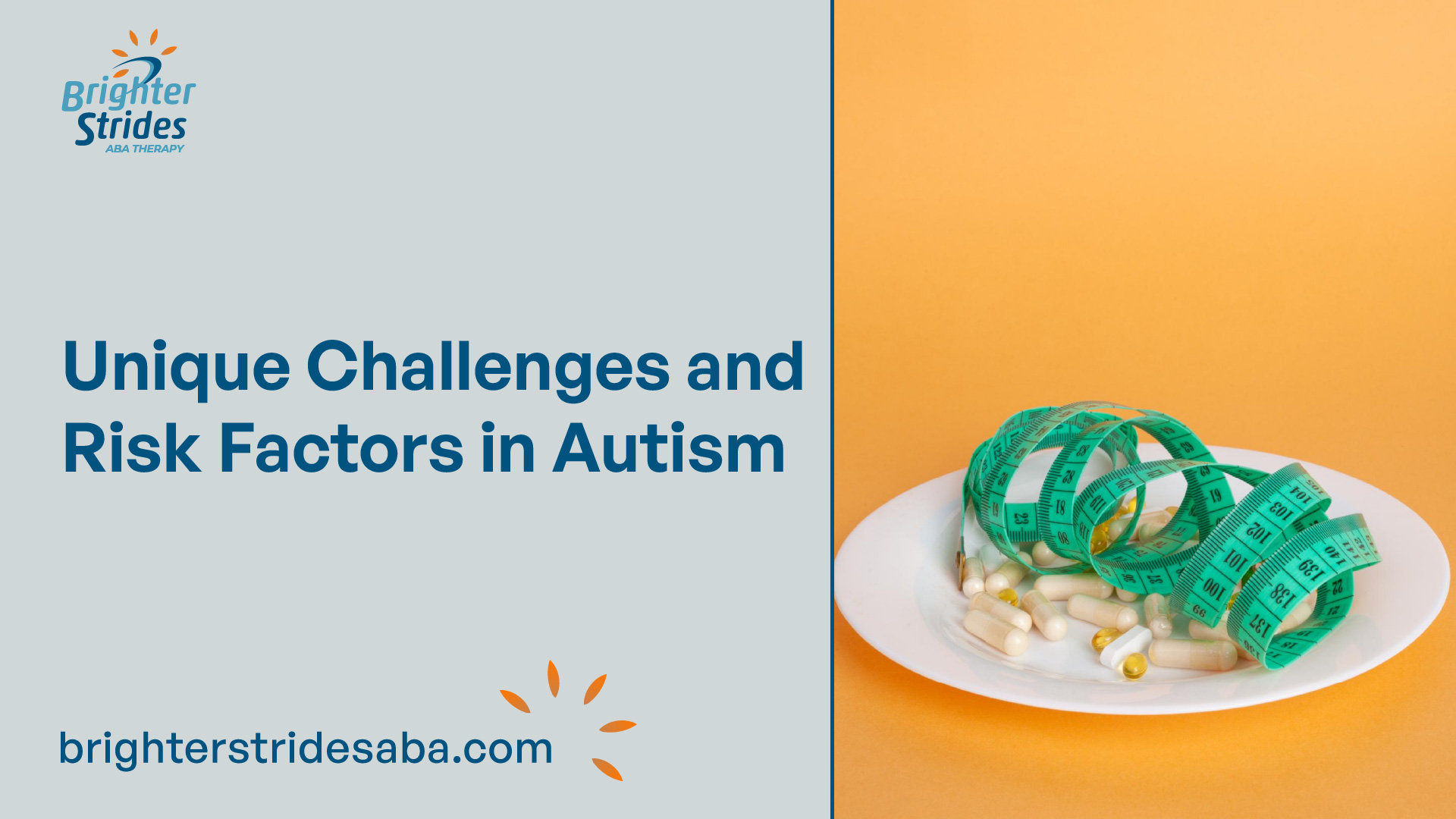Understanding the Link between Autism and Obesity
The link between autism and obesity has become an area of growing concern. Research has shown that individuals with autism spectrum disorder (ASD) are more likely to be obese compared to the general population. In this section, we will explore the prevalence of obesity in individuals with autism and the factors contributing to this association.

Prevalence of Obesity in Individuals with Autism
Multiple studies have highlighted the higher prevalence of obesity among individuals with autism. According to research published in Frontiers in Pediatrics, children with autism have 1.57 times the odds of being obese compared to children without autism. Additionally, around 20% of children and adolescents with autism were found to be obese, compared to 15% of their counterparts without autism. The prevalence of obesity in adults with ASD is even higher, ranging from 30% to 61%.
Factors Contributing to Obesity in Autism
Various factors contribute to the higher rates of obesity observed in individuals with autism. Some of these factors include:
- Genetic Predisposition: There may be a genetic predisposition to obesity in individuals with autism. Studies have suggested that certain genetic variations associated with autism may also be linked to an increased risk of obesity.
- Eating Behaviors and Food Selectivity: Many individuals with autism exhibit specific eating behaviors and food selectivity. This can result in a limited and often unbalanced diet, which may contribute to weight gain and obesity. Preferences for certain textures, tastes, or repetitive eating patterns can impact overall dietary quality and lead to an imbalance in nutrient intake.
- Sedentary Lifestyle and Physical Activity: Individuals with autism may face unique challenges in engaging in regular physical activity. Sensory sensitivities, limited motor skills, and reduced opportunities for participation in organized physical activities can contribute to a more sedentary lifestyle. Lack of physical activity can contribute to weight gain and obesity.
Understanding the prevalence of obesity in individuals with autism and the factors contributing to this association is crucial for developing effective strategies to address and manage obesity in this population. By recognizing these factors, healthcare providers and caregivers can tailor interventions and implement strategies to promote healthier habits and overall well-being in individuals with autism.
Health Risks Associated with Obesity in Autism
Obesity in individuals with autism spectrum disorder (ASD) is a significant concern due to its association with various health risks. Understanding these risks is crucial for addressing the unique challenges faced by individuals with autism and obesity. In this section, we will explore the health risks associated with obesity in autism, including cardiovascular diseases and metabolic syndrome, type 2 diabetes and insulin resistance, and the impact on quality of life.

Cardiovascular Diseases and Metabolic Syndrome
Individuals with autism who are obese have an increased risk of developing cardiovascular diseases and metabolic syndrome. According to research published in PubMed, the prevalence of obesity among children and adolescents with autism is higher compared to those without autism. This higher prevalence of obesity in individuals with autism contributes to an elevated risk of cardiovascular diseases, such as hypertension, high cholesterol, and heart disease.
Metabolic syndrome, a cluster of conditions including high blood pressure, high blood sugar, abnormal cholesterol levels, and excess abdominal fat, is also more prevalent in individuals with autism and obesity. These conditions can further increase the risk of developing cardiovascular problems, making it crucial to address obesity in order to mitigate these risks.
Type 2 Diabetes and Insulin Resistance
Obesity in individuals with autism is associated with an increased risk of developing type 2 diabetes and insulin resistance. The prevalence of obesity among adults with autism is higher compared to the general population, which increases the likelihood of developing type 2 diabetes.
Insulin resistance, a condition in which the body’s cells become less responsive to the hormone insulin, is commonly observed in individuals with obesity, including those with autism. Insulin resistance can lead to elevated blood sugar levels and, over time, may progress to type 2 diabetes. It is important to address obesity in individuals with autism to reduce the risk of developing these metabolic disorders.
Impact on Quality of Life
Obesity in individuals with autism can have a significant impact on their overall quality of life. Excessive weight can contribute to physical discomfort, limit mobility, and affect self-esteem. Individuals with autism may face additional challenges in managing their weight due to factors such as sensory sensitivities, eating behaviors, and a sedentary lifestyle.
Addressing obesity in autism is essential not only for physical health but also for promoting psychological well-being and social integration. By implementing tailored interventions, promoting healthy habits, and encouraging physical activity, individuals with autism can experience improved quality of life and overall well-being.
Understanding the health risks associated with obesity in autism is crucial for healthcare providers, caregivers, and individuals with autism themselves. By addressing obesity and its associated complications, individuals with autism can lead healthier lives with improved physical health, reduced risks, and enhanced overall well-being.
Unique Challenges and Risk Factors in Autism
Understanding the unique challenges and risk factors associated with obesity in individuals with autism is crucial for addressing this issue effectively. Several factors contribute to the higher prevalence of obesity in the autism population, including genetic predisposition, eating behaviors and food selectivity, as well as a sedentary lifestyle and reduced physical activity.
Genetic Predisposition to Obesity
Genetic factors play a significant role in the development of obesity in children with autism. Studies have identified specific genetic variants and copy number variants (CNVs) that are associated with both autism spectrum disorder (ASD) and obesity. For example, duplications and deletions at the 16p11.2 locus have been found to be linked to ASD and early-onset childhood obesity.
Eating Behaviors and Food Selectivity
Children with autism may exhibit eating disturbances and food selectivity, which can contribute to unhealthy weight gain. These challenges may manifest as a preference for certain textures, colors, or flavors, resulting in a limited variety of foods consumed. As a result, children with autism may have lower intake of certain essential micronutrients, such as vitamin A, vitamin D, B-complex vitamins, calcium, and zinc, potentially leading to increased fat deposition.
Sedentary Lifestyle and Physical Activity
Children with autism are more likely to have sedentary lifestyles and engage in less physical activity compared to their peers without autism [3]. Factors such as sensory sensitivities, limited social opportunities, and challenges with coordination and motor skills can contribute to reduced physical activity levels. Insufficient physical activity, coupled with a sedentary lifestyle, increases the risk of weight gain and obesity in individuals with autism.
Understanding these unique challenges and risk factors is essential for developing targeted interventions and strategies to address obesity in individuals with autism. By considering the genetic predisposition to obesity, promoting healthy eating habits and addressing food selectivity, as well as encouraging physical activity and providing appropriate accommodations, healthcare providers and caregivers can play a vital role in supporting the overall well-being and quality of life for individuals with autism.

Addressing Obesity in Autism
Addressing and managing obesity in individuals with autism requires tailored interventions, healthcare strategies, and a focus on promoting healthy habits and choices. By implementing these approaches, healthcare providers and caregivers can help improve the long-term health outcomes and quality of life for individuals with autism.
Tailored Interventions and Healthcare Strategies
Tailored interventions and healthcare strategies are essential when addressing obesity in individuals with autism. It is crucial to consider the unique needs and challenges faced by individuals on the autism spectrum. Some key considerations include:
- Individualized Treatment Plans: Developing individualized treatment plans that consider the specific needs and abilities of each person with autism. This may involve collaborating with healthcare providers, therapists, and nutritionists to create a comprehensive approach to address obesity.
- Behavioral Interventions: Implementing behavioral interventions to address eating behaviors and promote healthier choices. These interventions may focus on reducing food selectivity, promoting portion control, and encouraging mindful eating.
- Sensory Sensitivities: Taking into account sensory sensitivities and transitioning routines when introducing new foods or dietary changes. Modifying the sensory aspects of food, such as texture and presentation, can help individuals with autism feel more comfortable exploring a wider variety of healthy foods.
Promoting Healthy Habits and Dietary Choices
Promoting healthy habits and dietary choices is crucial in managing and preventing obesity in individuals with autism. This involves creating an environment that supports healthy eating practices. Some strategies to consider include:
- Education and Nutrition Guidance: Providing education and nutrition guidance to individuals with autism and their caregivers. This includes teaching them about balanced meals, the importance of portion control, and the benefits of nutrient-rich foods.
- Meal Planning and Preparation: Assisting individuals with autism and their caregivers in meal planning and preparation. This can involve creating structured meal schedules and involving them in meal preparation activities to increase their engagement and understanding of healthy eating habits.
- Supportive Food Environment: Creating a supportive food environment at home and school, with easy access to healthy food options. Limiting the availability of high-calorie, low-nutrient foods can help individuals with autism make healthier choices.
Encouraging Physical Activity and Exercise
Physical activity plays a vital role in managing obesity in individuals with autism. Encouraging regular physical activity and exercise can help individuals with autism maintain a healthy weight and improve overall well-being. Consider the following approaches:
- Individualized Exercise Plans: Developing individualized exercise plans that accommodate the specific needs and preferences of individuals with autism. This can include a variety of activities such as walking, swimming, cycling, and sensory-based exercises.
- Structured Physical Activity Programs: Encouraging participation in structured physical activity programs designed for individuals with autism. These programs may incorporate social aspects, sensory considerations, and specialized instruction to make physical activity enjoyable and accessible.
- Family Engagement: Involving family members and caregivers in physical activity routines to promote a supportive and active lifestyle for individuals with autism. Engaging in physical activities together can create positive reinforcement and foster a sense of community.
By implementing tailored interventions, promoting healthy habits and dietary choices, and encouraging physical activity, healthcare providers and caregivers can make a significant impact on managing and preventing obesity in individuals with autism. It is essential to approach these strategies with patience, understanding, and a focus on the unique needs of individuals on the autism spectrum.
Considerations for Healthcare Providers and Caregivers
Healthcare providers and caregivers play a crucial role in addressing and managing obesity in individuals with autism spectrum disorders (ASD). By understanding the unique needs and challenges faced by this population, they can implement effective strategies to promote overall well-being and quality of life. Here are some important considerations for healthcare providers and caregivers when working with individuals with ASD.
Sensory Sensitivities and Transitioning Routines
Individuals with ASD often have sensory sensitivities and difficulties with transitioning routines, which can impact their eating habits and physical activity levels. Healthcare providers and caregivers should take these challenges into account when addressing obesity in individuals with ASD.
Creating a supportive environment that considers sensory sensitivities can help facilitate healthier eating habits. This may involve adapting mealtime routines, offering a variety of sensory-friendly food options, and providing visual supports to aid in transitioning between activities. By understanding and accommodating sensory needs, healthcare providers and caregivers can help individuals with ASD develop a more positive relationship with food and mealtimes.
Managing Medications and Side Effects
Psychopharmacological treatments are sometimes used to manage certain symptoms associated with ASD. However, some of these medications may have side effects that can contribute to weight gain and obesity. It is important for healthcare providers to closely monitor individuals with ASD who are taking medication and regularly assess their weight and overall health.
If weight gain or other side effects are observed, healthcare providers should consider alternative treatment options or adjust medication dosages in consultation with the individual’s healthcare team. Open communication between healthcare providers, caregivers, and individuals with ASD is crucial for effective management of both symptoms and potential medication-related weight concerns.
Supporting Overall Well-being and Quality of Life
Promoting the overall well-being and quality of life for individuals with ASD goes beyond addressing obesity. Healthcare providers and caregivers should take a comprehensive approach that includes physical, mental, and emotional well-being.
Encouraging regular physical activity tailored to the individual’s abilities and preferences is essential. This can involve incorporating activities that the individual enjoys, such as swimming, dancing, or outdoor play. Engaging in physical activity not only helps manage weight but also promotes cardiovascular health, improves mood, and enhances overall well-being.
Additionally, providing social support and addressing any mental health concerns can contribute to the overall quality of life for individuals with ASD. This may involve connecting them with appropriate resources and therapies, such as cognitive-behavioral therapy or social skills training, to help manage stress, anxiety, and other mental health challenges.
By considering the unique needs and challenges faced by individuals with ASD, healthcare providers and caregivers can play a vital role in promoting healthy habits, dietary choices, and physical activity. Through tailored interventions and ongoing support, they can help individuals with ASD achieve a healthier weight, improve their long-term health outcomes, and enhance their overall quality of life.

 We've just released an article!
Check out our blog!
We've just released an article!
Check out our blog!



